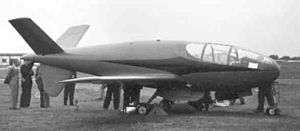Planet Satellite
The Planet Satellite was a British light aircraft of the late 1940s. Designed to exploit new technology, the aircraft was abandoned after two crashes although the innovative fuselage was later incorporated into a helicopter prototype.
| Satellite | |
|---|---|
 | |
| Planet Satellite during testing | |
| Role | Light aircraft |
| Manufacturer | Planet Aircraft Ltd. |
| Designer | Major Dundas Heenan |
| First flight | April 1949 |
| Introduction | Cancelled |
| Retired | 1958 |
| Status | Experimental |
| Number built | 1 (second prototype abandoned) |
| Variants | Firth Helicopter (fuselage used) |
Design and development
The Planet Satellite designed by Major J.N. Dundas Heenan was a futuristic looking four-seater built of magnesium alloy in a true monocoque "teardrop" shaped fuselage with no internal reinforced structure.[1] The Satellite was powered by a 250 hp de Havilland Gipsy Queen 31 mounted amidships driving a two-blade Aeromatic "pusher" airscrew in the tail.[2] Other notable features included "butterfly" tails and a retractable tricycle undercarriage, with the nosewheel retracting into a reinforced keel that ran the length of the underside of the fuselage.[1]
Breaking with conventional design and manufacturing conventions, Heenan declared in the July 1948 Aviation News issue, that the 400 drawings made were in stark contrast with the standard of approximately 3,000 drawings required for a project of that complexity.[3] Financing for the Satellite was equally novel with a partnership established with the Distillers Company Ltd. (makers of Gordon's Gin and Black Label Whisky) wherein the Planet Aircraft Company operated as a subsidiary of a liquor company.[4]
Built in the Robinson Redwing factory at Croydon, Purley Way, Surrey in 1947, the first prototype was taken to Redhill in 1948. The sleek light aircraft appeared at the S.B.A.C show at Farnborough in September 1948 and received the registration G-ALOI in April 1949.
Testing and evaluation
The Chief Test Pilot at RAE Farnborough, Group Captain H.J. Wilson (holder of the World speed Record in the Gloster Meteor), after several long runs down the runway, managed to get the Satellite airborne at Blackbushe. The first "hop" was followed by the collapse of the undercarriage. After repairs, the prototype was flown off the ground and after reaching an altitude of barely 20 ft was put down on the ground gently but nonetheless, the main keel had been cracked by the force of the landing. The conclusion of the Air Registration board investigating the "accident" was that the aircraft was badly under-stressed and would necessitate a complete redesign.[4]
The manufacturers had already begun the production of a second prototype and despite an investment of £100,000, chose to wind down the program with no further attempts to fly the Planet Satellite.
The second prototype, registered G-ALXP was abandoned but the completed fuselage was incorporated into the Firth Helicopter, built in 1952 at Thame. The single "flying" Satellite languished at Redhill until 1958 when it was unceremoniously broken up.[5]
Specifications (Planet Satellite)
Data from Heavenly Body[4]
General characteristics
- Crew: 1
- Capacity: 3 passengers
- Length: 26 ft 3 in (8.00 m)
- Wingspan: 33 ft 6 in (10.21 m)
- Height: 9 ft 3 in (2.82 m)
- Wing area: 153 sq ft (14.2 m2)
- Airfoil: NACA 23000 series
- Empty weight: 1,600 lb (726 kg)
- Gross weight: 2,905 lb (1,318 kg)
- Powerplant: 1 × de Havilland Gipsy Queen Inline piston, 220 hp (160 kW)
Performance
- Maximum speed: 208 mph (335 km/h, 181 kn)
- Cruise speed: 191 mph (307 km/h, 166 kn)
- Range: 1,000 mi (1,600 km, 870 nmi)
- Service ceiling: 22,000 ft (6,700 m)
- Rate of climb: 1,450 ft/min (7.4 m/s)
References
Notes
- Middleton 1983, p. 528.
- Air Progress, November 1978, p. 18.
- Middleton 1983, p. 529.
- Middleton 1983, p. 530.
- Middleton 1983, p. 531.
Bibliography
- Gunston, Bill. Back to the Drawing Board: Aircraft That Flew But Never Took Off. London: Zenith Imprint, 1996. ISBN 0-7603-0316-9.
- Middleton, Don. "Heavenly Body". Aeroplane Monthly Vol. 11, No. 10, Issue: no, 128, October 1983.
External links
- Secret projects UK
- Whisky business: The strange story of the Planet Satellite
- "Plane Resembles Torpedo." Popular Science, August 1948, p. 92, bottom of page.
Print Publication Mechanix Illustrated January 1949, p. 80 title "Tail-Prop Plane"